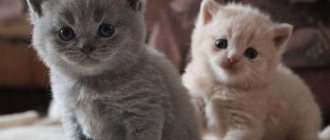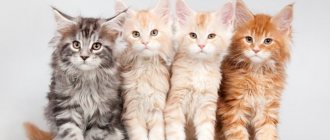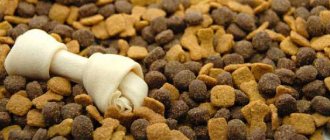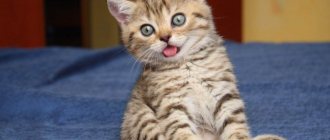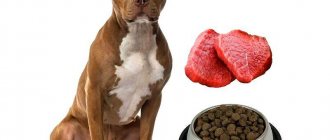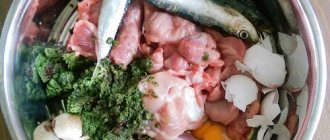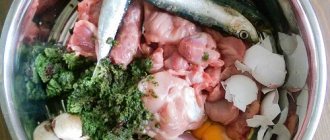Over the next months, the number of feedings is increased to 3 times a day. Milk is offered up to six months, after which it is not recommended, since the body of maturing animals reacts poorly to lactose. It is also necessary to ensure that there is always water in the bowl to quench your thirst.
After one and a half months, the kitten’s need for protein foods – meat, fish, eggs – increases. In any case, the diet should be balanced and contain the substances and microelements necessary for the development of fluffy fur.
What is better – natural food or dry food?
The debate about what is healthier – ready-made food or natural food – continues unabated. Dry granules and pates come to the rescue when the owner does not have time to prepare complex and healthy recipes. In addition, industrial feeds undergo a number of tests, so the composition of the product, if not ideal (preservatives, thickeners, etc. are present), is then balanced. Feeding natural foods also has a number of advantages:
- well absorbed by the animal’s body;
- is as close as possible to the natural needs of carnivorous predators;
- does not contain ingredients harmful to cats - salt, sugar and others.
The only negative is that you need to prepare food for the cat separately, since adding seasonings and spices for taste is unacceptable. In addition, you need to regularly give vitamin complexes.
What to feed a one-month-old kitten (up to 1 month)
A well-fed kitten either sleeps peacefully or quietly sucks the cat. But if kittens crawl around their mother, refuse the nipple, squeak and grab an outstretched finger - these are signs that the child is hungry.
Where to start with complementary feeding or full feeding of a week-old pet?
Prepare a bottle with a nipple, a dropper or syringe without a needle, and a special mixture designed to replace cat milk for a week-old kitten.
Here are some simple recipes on how to feed small kittens at home:
- Raw egg yolk + half a liter of concentrated milk
- Dry yeast (2.5 g) + whole milk powder (15 g) + whole cow's milk (50 g)
- Hard-boiled egg + beaten egg white + vegetable oil (1 g) + grape sugar (4 g)
- Half an egg yolk + corn oil (teaspoon) + whole milk (50 ml)
These and other recipes will also be useful if the kitten grows up without a mother cat and (correctly), its feeding is entirely your responsibility.
Read about recipes for feeding kittens up to a month without a cat
What foods should you not feed your kitten?
- Dry or wet food. There is no unanimity on this issue; rely on your own prudence and intuition. Therefore, here we put a question mark – ?
- Cow's milk. It is better to replace it with goat milk - it is not so fatty for the baby’s digestion. If you can’t get goat milk, then for very small kittens you can buy special powdered milk in pet stores
- Fermented milk products with high fat content
- Fish. In principle, children should not be given fish at all, but theoretically, sea fish is not harmful. Freshwater is prohibited, especially raw water, as it provokes the formation of urolithiasis and can become a source of infection with worms
- Salt, spices
- Sausages
- Potatoes are not at all digestible by the stomach of a domestic cat, so they are not given in any form.
- Legumes. Soy, peas, beans are not digested by the intestines and as a result we get bloating and fermentation in the intestines
- Cheese - due to its fat content
- Pork
- Sweets
- Chocolate. This particular sweet contains theobromine, a poison that causes severe poisoning and death in cats.
- Flour
- Mixed diet is harmful for kittens
Read more about what not to feed.
When can you switch to dry food and how to do it correctly?
When feeding a kitten older than a month, you should give preference to industrially produced wet food: pates, sauces, etc. They choose by carefully reading the labels on the packages - it always indicates what age the product is intended for. When feeding natural food, the food is ground for up to a month, and then the meat is cut or minced, asking the pet to cope with large pieces.
After 1.5-2 months, your pet can be offered dry granules. Only first they are soaked in milk (goat milk or milk substitute), plain water and left in a bowl. If the baby easily copes with this type of food, then some of the granules are soaked and mixed with dry ones (no more than 20% of the serving volume on the first day). If the kitten has no visible digestive problems, the percentage of dry food is increased every couple of days, transferring the animal completely to dry food.
You cannot feed not only a kitten, but also an adult cat (feline) only dry food! This can lead to bowel problems and dehydration. It is recommended to alternate dry and wet types of food, then the diet will be closer to balanced.
Feeding kittens without a cat
In the first days of life, mother's milk helps the kitten better adapt to new conditions. But it happens that babies are deprived of parental warmth early. You have to feed the kitten yourself. A special mixture that is sold in pet stores is suitable for this. It should be used to feed kittens in the first month after birth.
You cannot replace the mixture with cow's milk - it is permissible to use it only after a month, otherwise the kittens will develop diarrhea, and they may even die, because their stomachs are still very weak to digest complex food. It’s better to feed your baby goat’s milk for some time after using a mother’s milk substitute. This rule is relevant not only for purebred animals, but also for yard kittens.
For feeding, it is convenient to use a pipette or a bottle with a small nipple (all of this is also sold in pet stores). The second option is more preferable, since it is important to develop a sucking reflex in the baby. If it is not yet available, use a pipette to get a few drops of the mixture into the kitten's mouth, and then immediately apply it to the nipple - this way he will understand what needs to be done. In addition to the mixture, you can give the kitten warm water using a pipette or syringe.
Another option is to find a wet nurse. A cat that has recently given birth can feed a baby left without a mother.
Types of dry food for kittens
All finished products, which are offered by various manufacturers, are divided into classes. Each has both pros and cons.
Economy class food
These are the brands that constantly appear in advertising and are presented in a wide range on the shelves of any supermarket: Kitikat, Whiskas, Sheba and others. The products of the listed brands are affordable, but the composition is not always up to par. Disadvantages include:
- low meat content;
- the presence of various taste stabilizers, thickeners, etc.;
- the presence of cereals harmful to the cat’s body, for example, corn.
But the variety of different flavors and textures, combined with low prices, is helping to popularize inexpensive brands. In order not to treat your beloved pet later, it is better to avoid economy-class food or give it very rarely.
Premium products
This class includes the brands “Hills”, “ProPlan”, “Akana”, “Royal Konin”. The composition contains a higher percentage of pure meat, grains and vegetables. The food is enriched with vitamin and mineral complexes and is suitable for a complete daily diet. There are specialized lines for small kittens, spayed and neutered, as well as older animals. The cost is higher compared to economy segment products. When buying such food, the owner can be sure that the cat will not only be well fed, but will not “earn” sores.
Holistic
These are products of the highest quality, containing only natural meat without processed products. The manufacturer guarantees that the animals are raised in excellent conditions and are fed only healthy food. The finished products do not contain chemical additives, GMOs, soy, or corn. The cost of food in the holistic segment is very affordable.
A small kitten needs tireless care and frequent feeding. This is especially important if the pet was left without maternal affection at an early age. Organizing care is difficult, but quite possible. The feeding schedule changes as the baby grows and is 8-10 times in the first 2 weeks of life; 7-8 times a month; 6-7 – at two months; 5 servings per day at 3-4 months and 2-3 for adolescents and adult animals. Newborns and toddlers are fed only milk (goat's milk) or milk substitute. Older adults require more food, so complementary foods are introduced from 1.5 months. For full development, a kitten needs a balanced diet, so you can either buy ready-made (dry and wet) food, or diversify natural food. Whether your pet will be healthy, cheerful and active directly depends on the quality of food, which the owner must take care of!
What foods can you feed a kitten?
Remember that the food you put in your kitten's bowl should never be hot or cold. It is optimal if the food is at room temperature.
It is important to remember the consistency of food - it is better if the first portions are mushy and do not contain solid pieces. At home, a blender or an ordinary grater for milking vegetables will help with this.
So, what to feed a kitten:
- Meat. It can be raw, boiled, frozen and scalded. 60-80% of a kitten's daily diet comes from lean meat. What kind of meat is suitable for a kitten - see the table below;
- Liver. Offered once every 1-2 weeks;
- Porridge. In their pure form, the kitten is unlikely to be interested in them, but adding meat or vegetables radically changes the matter. Mix porridge with meat in a 1:2 ratio;
- Vegetables. Fresh or boiled;
- Eggs. What do kittens eat from eggs? Exclusively yolk. It is useful to give a raw yolk to a kitten once a week. Pay special attention to quail eggs - they are very healthy and quail eggs can be given whole, without separating the white from the yolk;
- Fermented milk products with low fat content;
- Brewer's yeast;
- Oil. Experts recommend avoiding vegetable oil and replacing it with Vaseline.
Water in the diet
The right amount of fluid is vital for metabolism. The kitten does not experience an urgent need for additional moisture if it is mother-fed. After offering additional food to your pet, make sure there is enough water in the diet.
Kittens do not like to drink water and may refuse water completely. The solution is to add water to supplementary meals. All food should be liquid in consistency. As an option: place a bowl of water next to the food, and occasionally the kids start drinking water on their own.
Consequences of poor nutrition
Poor nutrition, especially during the growth period, is the cause of many diseases and disorders:
- Stunted growth;
- Incorrect formation of the skeleton;
- Metabolic disorders;
- Reduced immunity;
- Allergic reactions;
- Poisoning;
- Worm infestations;
- Reproductive dysfunction.
Without following the basic rules and norms of feeding, it is impossible to raise a healthy animal that meets all the characteristics of the breed.
Feeding frequency and portion size
When feeding “dry”, it is enough to focus on the norms indicated on the packaging. By weighing your pet, you can easily find out its daily portion.
The frequency of feeding depends only on age, so it is the same for pets with different types of nutrition. The recommended number of meals and portion sizes on natural food can be found in the table.
| Age | Feeding frequency (once a day) | Daily serving size |
| Up to 2 weeks | 10, including night time | 30 ml per 100 g weight |
| 2-3 weeks | 9, including night time | 40-45 ml per 100 g weight |
| 3-4 weeks | 8, including night time | 50-55 ml per 100 g weight |
| 1-2 months | 7 | 120 g |
| 2-3 months | 6 | 150 g |
From three months of age, the portion size is increased to 200 g per 1 kg of weight, and the number of meals is reduced to 5. From this moment until six months, the animal enters the most active growth phase. At this time, veterinarians recommend taking into account the individual characteristics of the pets and monitoring their well-being by checking their indicators in the clinic. If you deviate from the norm typical for your pet's breed, you may need to increase or reduce the usual portions.
If you are often away from work, make sure that your friends, relatives or neighbors feed the kitten. Eating too infrequently can lead to overeating or exhaustion. After six months, your pet can be safely switched to three meals a day, and closer to a year - to two meals a day.
Rules for introducing complementary foods
The little pet begins to be fed from 4-8 weeks, gradually diluting the milk menu with more solid products. When introducing complementary foods, follow these rules:
- Puree your meals and focus on carbohydrates and calcium. Cook milk porridges and use a limited amount of meat until baby teeth erupt.
- Add new dishes at intervals of 2-3 days to track the body's reaction. This will help identify allergies and food intolerances.
- Offer to try unfamiliar food straight from your finger. After approval, it can be poured or transferred to a bowl.
- Consider your pet's tastes. If the cat refuses the food offered, you should not force feed it. Thanks to the variety of possible options, the diet can be chosen to suit every taste.
- Avoid food that is too hot or cold. Temperatures above and below room temperature can injure mucous membranes.
- Don't leave uneaten food for later. To avoid indigestion and poisoning, serve only fresh food.
- Try to eliminate sources of noise while eating. Without being distracted by irritants, the baby will focus more on food and quickly learn to eat on his own.
- Avoid overfeeding. Not all babies feel full. It is safer to feed them often, but in small portions.
You can determine the time of introducing complementary foods in the presence of a mother cat by changing her behavior. By 4-6 weeks after birth, her milk supply decreases, so she increasingly leaves the “nest”. With the developed maternal instinct, the pet begins to take the cubs to the kitchen, showing them bowls of food. By repeating after their mother, babies quickly learn to eat on their own.
Getting your kitten used to solid food
With the appearance of baby teeth, you can diversify your diet with solid foods. Instead of minced meat, offer your pet finely chopped meat and fish pieces. Use only low-fat varieties, not forgetting about pre-freezing and cooking. Two-stage treatment at different temperatures will eliminate infection by parasites.
Gradually reduce the amount of liquid in porridges by adding meat to them. The baby quickly gets used to this additive in broths and cereals, but you will have to tinker with the individual serving of meat. If the pieces remain in the bowl, then try grinding them into minced meat and offering them again. Having become accustomed to the smell and taste, the cat will begin to eat meat in larger quantities.
What should kittens not be given during their growth period?
- Cow's milk is not suitable for kittens; it does not provide the body's basic needs and is difficult to digest.
- Raw river fish – causes a lack of vitamin B and helminthic infestations.
- Fermented milk and dairy products with a high fat content.
- Fatty meats, pork.
- Sausages, smoked meats, products containing salt and spices.
- Potatoes and legumes are not digestible by cats; in addition, legumes cause fermentation in the intestines.
- Flour products and sweets do not bring any benefit to the body and contribute to excess weight gain.
- Chocolate is dangerous for cats and contains a substance that is toxic to this type of animal.
Forbidden food
Do not forget that any food from the human table is contraindicated for pets. Stop any attempts by compassionate relatives to feed your “unlucky” pet pickles, sweets, herbs, smoked meats, flour, fried and fatty foods. A moment's pleasure can turn into a long and expensive treatment.
In addition to the foods listed, avoid feeding:
- pearl barley and millet;
- sorrel, onion and garlic;
- any bones;
- pork;
- mushrooms and potatoes;
- raisins and grapes;
- legumes
Don't believe the myths about the benefits of milk and fish. After a year, cats develop lactose intolerance, accompanied by diarrhea and increased gas production. Fish is fraught with the development of urolithiasis and kidney inflammation, so it is also better to avoid its frequent consumption.
Food basket for kittens
Let's look at the cat's “food basket” - what you can feed kittens from homemade food, that is, “natural food”. The first thing is meat, namely beef. A bird would also work. It is better to avoid pork; a kitten can easily overeat it out of habit; on top of everything else, it is a source of helminthiasis infection. If we talk about fish, there is nothing better than sea fish. You can get a lot of things from river fish. But even sea fish should be given infrequently - a couple of times a week is more than enough. For young creatures, the meat must be boiled, but older pets can eat it raw, but only in moderation.
What better way to feed a kitten than with milk; there is simply no dearer food for it. However, not every cat will drink cow's milk. In some animals, the stomach simply cannot tolerate it. In such cases, the baby can be given yogurt or other fermented milk product. The main thing is that its fat content is not too high. Another good product for a growing animal is cottage cheese. Small pets are given cottage cheese puree with yolk, milk, or all together. Few people will refuse such “mogol-mogol” and usually the kitten devolves it with great pleasure. You can also pamper your pet with rennet cheese and sour cream.
In order for an animal to develop fully, it requires fiber contained in products of plant origin - these are vegetables and cereals. To compensate for this need, the kitten needs to cook porridge. For the smallest kittens, on a milk basis, and for older animals on meat, chicken, and fish broths. Only legumes should be avoided, since it has already been mentioned that feeding legumes leads to bloating and constipation, and they are also poorly absorbed by the body. Meat and vegetables are added to porridges made with meat broths.
Don't forget that your baby should have 24/7 access to fresh water. This aspect is especially important when feeding dry food. After all, cats that consume store-bought food drink almost four times more water than animals that eat natural products. Change the water regularly, and wash the container underneath and scald it with hot water.
Natural nutrition
Those who adhere to the position of feeding kittens with natural food are confident that only such food is safe and healthy for them. Naturally, for them there is no question of what to feed the baby at this age, since they have already made their choice. However, it is worth noting that natural foods that are considered acceptable for kittens are not at all the same products that humans consume. This is a specially produced food that contains useful substances and no chemical additives.
Features of the digestion of small kittens
Before you create the right diet for your pet, you need to know the digestive characteristics of small kittens. Unlike adult cats, the digestive tract of kittens up to 7-8 months is quite vulnerable. Therefore, any errors in feeding and diet, violation of the regime, daily routine can result in nutritional (food) allergies and disruptions in the functioning of the gastrointestinal tract.
Important! An unbalanced diet in kittens is the first step to the development of chronic diseases of the digestive tract. Improper feeding and diet slows down the growth and development of the kitten, leads to external defects and can even cause death.
The digestive characteristics of kittens are individual. Depends on age, breed, rate of development, growth, conditions of detention.
Until 1-2 months, the main food for kittens is mother's milk, with which babies receive immune protection (antibodies) necessary for normal functioning, growth and development.
If the kittens are left without a mother, the owners must take full care of the newborn babies.
At approximately 2.5 months, the kitten’s gastrointestinal tract is ready to absorb new food and products. Therefore, from this age you can start complementary feeding. To do this, use special food for small kittens, infant formula, meat and semi-meat purees, and mousses.
To prevent the transition to new food from becoming a serious stress for the body, new foods are introduced gradually, in small portions.
At the initial stage, almost all food is mixed with milk, other dairy and fermented milk products. First, one type of food is used for feeding, and if there is no disorder, new foods are gradually introduced into the diet.
Advice! When a kitten is weaned early from its mother cat, the majority of the diet consists of specialized milk formulas. It is also worth noting that after you bring your pet home, it should initially receive the same food as the breeder provided. Therefore, ask what was used for complementary feeding.
As you get older, your digestive tract loses its ability to digest lactose (milk sugar), so milk and other dairy products can cause stomach upset. At the age of 4-5 months, the body produces the enzyme amylase, which is necessary for the digestion of starch.
Remember that cats are predators, carnivores, so for normal functioning of the gastrointestinal tract they require sufficient amounts of protein, which is contained in meat products. But this does not mean that the kitten needs to be fed exclusively meat if you plan to keep your pet on a natural diet. Nutrition should not only be balanced, but also varied.
